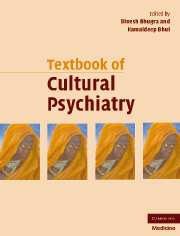Book contents
- Frontmatter
- Contents
- Contributors
- Foreword
- Preface
- Part I Theoretical background
- 1 Cultural psychiatry in historical perspective
- 2 Anthropology and psychiatry: the contemporary convergence
- 3 Suicide, violence and culture
- 4 Psychology and cultural psychiatry
- 5 Spirituality and cultural psychiatry
- 6 Culture, ethnicity and biological psychiatry
- 7 Ethnic inequalities and cultural capability framework in mental healthcare
- Part II Culture and mental health
- Part III Culture and mental disorders
- Part IV Theoretical aspects of management
- Part V Management with special groups
- Part VI Cultural research and training
- Cultural psychiatry: the past and the future
- Index
- References
2 - Anthropology and psychiatry: the contemporary convergence
from Part I - Theoretical background
Published online by Cambridge University Press: 11 August 2009
- Frontmatter
- Contents
- Contributors
- Foreword
- Preface
- Part I Theoretical background
- 1 Cultural psychiatry in historical perspective
- 2 Anthropology and psychiatry: the contemporary convergence
- 3 Suicide, violence and culture
- 4 Psychology and cultural psychiatry
- 5 Spirituality and cultural psychiatry
- 6 Culture, ethnicity and biological psychiatry
- 7 Ethnic inequalities and cultural capability framework in mental healthcare
- Part II Culture and mental health
- Part III Culture and mental disorders
- Part IV Theoretical aspects of management
- Part V Management with special groups
- Part VI Cultural research and training
- Cultural psychiatry: the past and the future
- Index
- References
Summary
EDITORS' INTRODUCTION
Anthropology and psychiatry as disciplines appear to have a considerable amount of common ground. Both are interested in human beings, the societies within which they live and their behaviours. A key starting difference between the two is anthropology's interest in relativism, whereas psychiatry has been interested in universalism. Also, both anthropology and psychiatry have a long history of common interest in phenomenology and the qualitative dimensions of human experience, as well as a broader comparative and epidemiological approach.
Jenkins illustrates the common ground by emphasizing that both disciplines contribute to the philosophical questions of meaning and experience raised by cultural diversity in mental illness and healing. Both disciplines also contribute to the practical problems of identifying and treating distress of patients from diverse ethnic and religious groups. Psychiatry focuses on individual biography and pathology, thereby giving it a unique relevance and transformation. Patient narratives thus become of great interest to clinicians and anthropologists. Development of specializations such as medical or clinical anthropology puts medicine in general and psychiatry in particular under a magnifying glass. Using Jungian psychology as an exemplar could lead to a clearer identification of convergence between the two disciplines. The nexus between anthropology of emotion and the study of psychopathology identified in her own work by Jenkins looks at normality and abnormality, feeling and emotion, variability of course and outcome, among others. She ends the chapter on an optimistic note, highlighting the fact that the convergence between these two disciplines remains a very fertile ground for generating ideas and issues with the potential to stimulate both disciplines.
- Type
- Chapter
- Information
- Textbook of Cultural Psychiatry , pp. 20 - 32Publisher: Cambridge University PressPrint publication year: 2007
References
- 11
- Cited by

